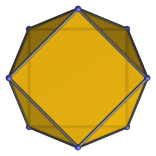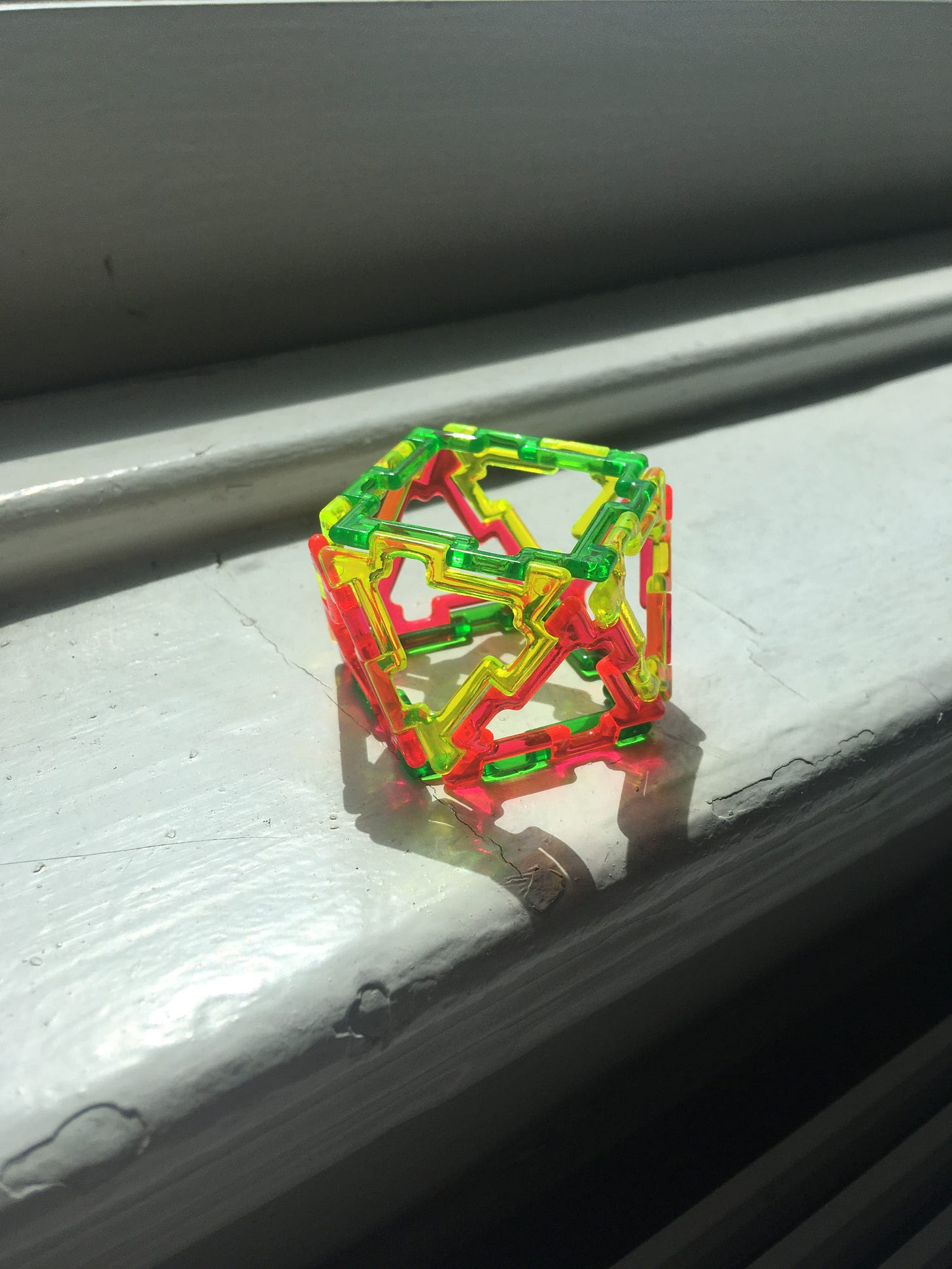Let’s talk about prisms and antiprisms. Prisms are what you get when you take two congruent bases and do the sensible thing—connect them with rectangles, or maybe parallelograms, so that those two bases have the same orientation.
But what if you don’t want to do the sensible thing? What if you want to connect a bunch of triangles to the edges of each base? And what if you then try to connect all those triangles together? You may realize that you’ll have to twist one of those bases a bit to make it all work, and then—boom! You’ve made an antiprism.
The image above comes from a very fun and incredibly well-designed website called Polyhedra Viewer made by Nat Alison. In the image, there are 12 vertices. There is a face attached to each edge, plus the two bases, making 14 faces. How many edges can you count?
The textbook Discovering Geometry has a nice little table that may draw your (or your students’) attention to how the vertices, edges and faces of an antiprism all work out in antiprisms. For the hexagonal antiprism that’s 14 total faces, 12 vertices, and 24 edges (6 for each hexagon, and then 12 more edges for all those triangles).
If you’re not familiar with Euler’s polyhedron formula, it’s not too late — it states that the vertices + faces - edges always equals 2 for polyhedra, and it’s such a fundamental result that it basically describes the space we live in. I find that amazing.
There is a sort of famous square antiprism hanging out the window of my school. (Though the bases aren’t equal, so it doesn’t really count.)
The square antiprism really captured my attention. It is sometimes called a squap. We have these clicky polyhedra toys at school, and I built a square antiprism with them. Holding it in my hand, I was much better able to understand that its cross-sections would be a series of octagons, twisting on top of each other until they taper off into square.
In fact, if you look at it from directly above you’ll see a regular octagon.

What would its volume be?
The mathematical internet will give you a value for its volume. You can find it on the remarkably comprehensive Polytope Wiki. (Polygons are 2D, polyhedra are 3D, polytopes are N-dimensional.)
I have not yet been able to figure out how to compute that volume. Alas.
What else can I tell you about square antiprisms? Apparently they show up in chemistry. 13 square antiprisms can make a ring, though it doesn’t do so regularly. Someone has put together an antiprism volume calculator, but I don’t yet know how it works. There is something called the squap army, that’s strange!
There is no “antiprism theorem.” There are no elegant formulas for describing their properties. Every shape is special, but they are not especially so.
And yet there are classification systems for all these antiprisms—and for polyhedra more generally—that I don’t understand. There are several notations for summarzig their properties. There are groupings and families and extensive categorizing, all done by a cadre of experts. As far as I can tell, it’s not because these polyhedra are deeply significant for mathematics or science.
No, it’s just that some people just love these funny little shapes. And having spent a week with them, I can understand why. Congratulations to antiprisms, last week’s shape of the week.
Update: My brilliant colleague has figured out how to find the volume of the square antiprism! He tells us to imagine the antiprism as if it’s embedded in a frustum. That did the trick! (Incidentally, there are some cool volume formulas for frustums.)







Have you considered using Modular Origami to teach some of these concepts?
Lots of fun and so much potential. I recently took out of the library the book "The Art and Science of Geometric Origami by Jon Maekawa. Excellent book with lots of ideas.
Smart comment: https://twitter.com/DrPMaths/status/1651101773774372864